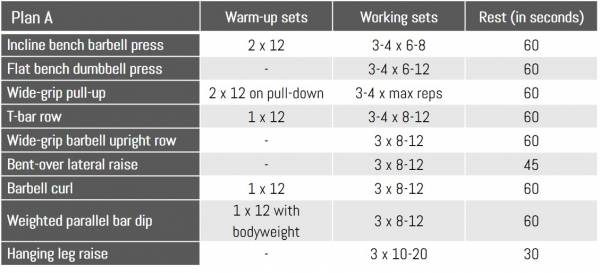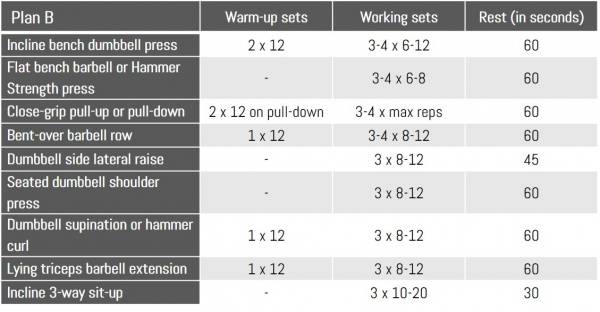With all the training protocols out there, it’s a bit surprising that most average Joes in the gym are still training a single muscle at a time, instead of the body as a whole. “Bro splits” dominate the gym on any given week. Let’s all say it together: chest on Monday, back on Tuesday… You would think that everyone is following the exact same weekly program, despite the fact that each person’s response to a training stimulus is unique.
In fact, everyone’s plans do seem to be identical. For example, on international chest day (Monday) most will begin with bench presses, followed up by some sort of incline work, and then on to a fly or cable motion.
The principles of weight training aren’t rocket science. However, the common practice of sorting out your movements into the smallest possible amount of isolation needs a second look. What’s next? Left and right biceps on different training days?
Why Bicep Day Doesn’t Work for Every Bro
If everyone is training the same way, why do some get rapid results while others seem to progress at a snail’s pace? Everyone responds to training differently due to many factors. Genes do play a role, but since you can’t do anything about them, let’s look at what else is in play:
- Ability to recover: This is influenced by nutrition habits and the amount of sleep you get. Having a sound nutrition program can make or break your success in the gym. So can sleep. Too many pay little attention to the amount of rest needed to truly progress in the gym.
- Stress levels: High stress levels excrete more muscle-destroying cortisol in your blood stream. Stress can zap strength and recovery ability. No, you can’t eliminate stress out of your life completely, but you can reduce and manage it.
- Schedule: Consistency and persistence are two key principles needed to succeed. Without the daily, weekly, and monthly dedication to your plan, little or no progress will be made.
- Intensity: Intense workouts produce results, not an hour-long session of checking your phone. Enough said.
- Planning: You can’t build anything worthwhile without a sound, thoughtful plan.
- Motivation: Derive your motivation from somewhere; a contest, friends, yourself, it doesn’t matter. Just make sure you have a motivational vision in place.
You Are Not a Pro Bodybuilder
High level, professional bodybuilders have made the micro-split routine commonplace. Most gym bros look up to the biggest dude in the gym or on the magazine cover, and can’t help but follow his routine. The problem is that most, if not all pros are “pharmaceutically enhanced,” shall we say. They are able to stimulate growth with almost any routine. It’s easier for them to blast one body part per day and then go home and grow since their body is in a constant anabolic state.
You are natural. You aren’t able to get a sleeve-busting response from twenty sets of curls. Your body works better when it is trained as a whole. The more muscle stimulated in a single, well-considered training session, the better your body’s response to that stimulus will be.
Replace the Micro Splits With Compound Movements
Okay, now let’s get back to the task at hand. If you have covered all the bases laid out above, it’s time to structure your upper body training. First and foremost, ditch the one-body-part-per-day stuff. If that has worked for you in the past, then you wouldn’t have read this far, so you must not get great results from that tired old routine.
Second, know that the body works better and more efficiently when larger areas are stimulated versus smaller areas. For example, to induce hypertrophy in your arms, you will reap bigger rewards from all of the presses, rows, and pull-ups, versus cranking out endless sets of concentration curls and cable press-downs.
The same can be said for body part splits. You will stimulate more growth from training groups of muscles rather than isolating each one each day. If you train chest, for example, you will have saturated most of your upper body with blood. It would only make sense to take full advantage of this and train your back as well, giving your entire upper body a jolt of stimulation to grow.
If you’re the average gym-goer trying to increase general strength and size, then a full upper body workout will benefit you more than splitting up every little muscle group on its own day.
Rules for Your Upper Body Program
Now that you have decided to train the upper body as a whole, let’s set some ground rules. Below are a few general principles to follow when structuring your new training plan. Feel free to tweak them to fit your personal needs.
- Stimulate, don’t destroy. The object is to coax the muscle to grow, not squeeze the life out of it until it can’t even move. Train to stimulate, and then leave and recover for the next workout.
- Stay compound. Mostly use the big, multi-joint moves. These will give you the most bang for your buck.
- Limit isolation. Your upper body training doesn’t have to be completely void of isolation work, but too many curls won’t do you any good. Stick with just a few of the basics.
- Increase frequency. Since you will be consolidating many body parts into one session, you will be able to train more often during the week—as long as volume is kept in check. This will give you more opportunity for growth.
- Back off when necessary. Nobody’s life is perfectly consistent. You will have times when life gets stressful and you can’t recover as well as before. In these times, back off a bit to stave off injury and illness.
- Don’t let soreness be your guide. At first, you may feel a bit sore from training more frequently. Over time, this will subside and work to your advantage. As long as you are regulating volume and intensity, the slight soreness should be a nonissue.
Sample Upper Body Training Plans
Below are two examples of upper body plans. Use either one twice per week, or both once per week. Either way, you will want a weekly training frequency of two upper body workouts.


It’s Simple: Train Hard, Get Bigger
Training for muscle growth isn’t all that complicated. All it takes is the right amount of stimulation and the correct dose of frequency. Annihilating your chest with endless reps of cable flys every Monday isn’t going to get it done. Sure, it might feed your ego, but are you seeing any results? Give the above programs a try, work diligently for at least four to six weeks, and then reap big rewards. You only have muscle to gain.
Being huge might not be all it’s cracked up to be:






